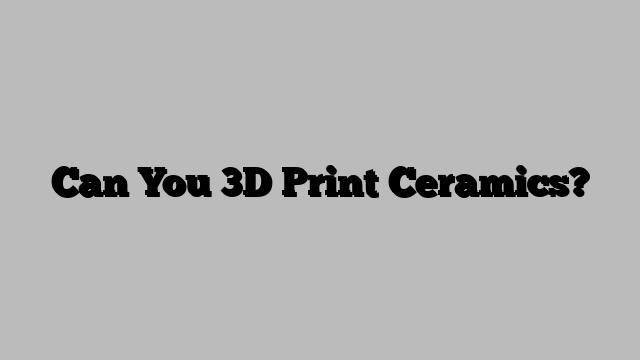Can You 3D Print Ceramics?
Ceramics have been an essential part of human civilization for thousands of years, with applications ranging from functional items such as pottery to decorative items like sculptures. With the advent of 3D printing technology, it is now possible to create ceramic objects using digital designs and specialized printers. In this article, we’ll explore the question of whether or not you can 3D print ceramics, as well as the process and materials involved.
Can You 3D Print Ceramics?
The short answer is yes, you can 3D print ceramics. However, it is not as straightforward as other materials such as plastic or metal. 3D printing ceramics requires specialized equipment and materials, and the process can be more complex.
How Does 3D Printing Ceramics Work?
Ceramic 3D printing involves the use of a special printer that is designed to print with a ceramic material. The process generally involves depositing layers of ceramic material to gradually build up the final object. There are different approaches to 3D printing ceramics, but some of the most common include:
Binder Jetting: This method involves depositing a ceramic powder layer-by-layer and binding it together using a liquid binder. The resulting object is then sintered at high temperatures to create a solid ceramic part.
Stereolithography: Stereolithography (SLA) is a type of 3D printing that uses a UV laser to cure liquid resin into a solid shape. In ceramic 3D printing, the resin is infused with ceramic particles to create a ceramic material that can be cured into a solid object.
Powder Bed Fusion: This method involves fusing together ceramic particles using a heat source, such as a laser or electron beam. The ceramic powder is spread out in a thin layer and selectively melted to create the desired shape.
What Materials Are Used?
The materials used for 3D printing ceramics can vary depending on the printing method used. Some common materials include:
Ceramic powders: These powders can be made from a variety of ceramic materials, such as alumina, zirconia, or silica. The powders are mixed with a binder and deposited layer-by-layer to create the final object.
Ceramic resin: This material is a liquid resin that is infused with ceramic particles. The resin is cured into a solid shape using a UV laser.
Ceramic filaments: These filaments are made of ceramic materials and are used with a specialized 3D printer to create ceramic objects.
How Much Does It Cost?
The cost of 3D printing ceramics can vary depending on several factors, such as the size and complexity of the object, the printing method used, and the materials used. Generally, 3D printing ceramics is more expensive than other materials such as plastic or metal, due to the specialized equipment and materials required. However, the cost has been decreasing in recent years as the technology becomes more widespread and accessible.
Conclusion
3D printing ceramics is possible and can be achieved using specialized equipment and materials. While the process can be more complex than other materials, the ability to create custom ceramic objects using digital designs opens up new possibilities in the field of ceramics. As the technology continues to advance, the cost of 3D printing ceramics is likely to decrease, making it a more accessible option for both hobbyists and professionals alike.
